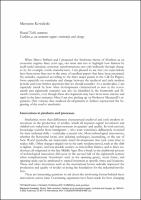Chapter Round Table comment. Fashion as an economic engine: continuity and change
| dc.contributor.author | Kowaleski, Maryanne | |
| dc.date.accessioned | 2022-06-01T12:29:44Z | |
| dc.date.available | 2022-06-01T12:29:44Z | |
| dc.date.issued | 2022 | |
| dc.identifier | ONIX_20220601_9788855185653_795 | |
| dc.identifier.uri | https://library.oapen.org/handle/20.500.12657/56611 | |
| dc.description.abstract | This comment points out the medieval precedents of many developments characterized as new in the early modern manufacture, sale, and consumption of fashionable textiles and clothing, although these developments were more rapid and intense in the later centuries. There was, for example, a significant break in the traditional process of technological innovations in the second half of the eighteenth century, when a series of complementary inventions radically improved the production and quality of textiles. In terms of commercial strategies and consumer behavior, however, there was less significant change, although the role of the second-hand trade deserves closer attention. The comment ends by highlighting how speakers have drawn on new methodologies and sources fo understanding the relationship between fashion and the economy | |
| dc.language | English | |
| dc.relation.ispartofseries | Datini Studies in Economic History | |
| dc.subject.other | fashion | |
| dc.subject.other | innovation | |
| dc.subject.other | shopping | |
| dc.subject.other | consumer behavior | |
| dc.subject.other | methodology | |
| dc.title | Chapter Round Table comment. Fashion as an economic engine: continuity and change | |
| dc.type | chapter | |
| oapen.identifier.doi | 10.36253/978-88-5518-565-3.23 | |
| oapen.relation.isPublishedBy | bf65d21a-78e5-4ba2-983a-dbfa90962870 | |
| oapen.relation.isbn | 9788855185653 | |
| oapen.series.number | 2 | |
| oapen.pages | 7 | |
| oapen.place.publication | Florence |

